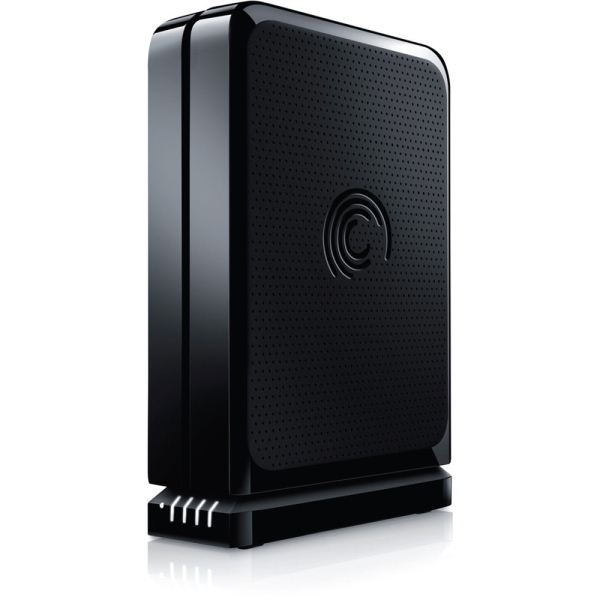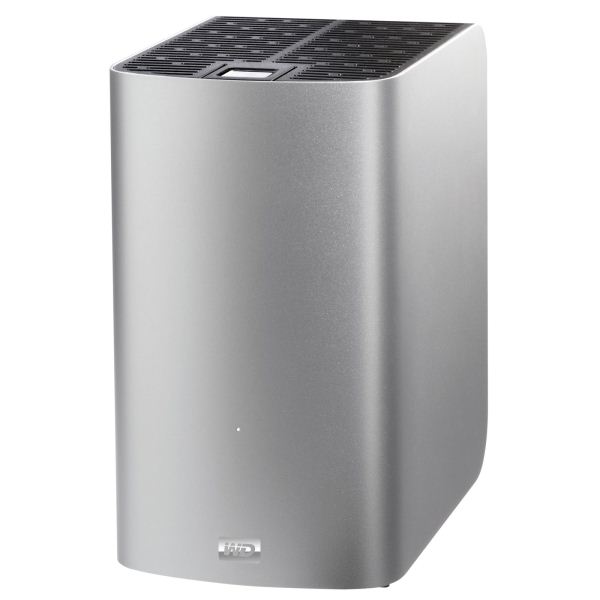A Tale Of Two Thunderbolt Storage Devices: Seagate's GoFlex Desk and Western Digital's Thunderbolt Duo
by Brian Dipert on May 13, 2012 7:52 PM EST- Posted in
- Thunderbolt
- Seagate
- WD
- Western Digital
I remember the early days of the USB-vs-FireWire wars like they were yesterday, although Wikipedia reminds me that they were more than a decade ago (sigh). USB 1.0 arrived in 1996 but didn't begin to see broad adoption until two years later with version 1.1. When FireWire 400 (aka IEEE 1394a) emerged on Apple systems in 1999, its backers scoffed at USB's comparatively diminutive 11 Mbps peak (and much lower practical) bandwidth.
Intel and its partners' response was swift; USB 2.0 came on the scene in 2000. Its 480 Mbps theoretical peak bandwidth, coupled with Intel's refusal to integrate FireWire support within its core logic chipsets, doomed FireWire to niche status in spite of the subsequent emergence of the 800 Mbps IEEE 1394b variant.
Yet as anyone who's used a USB 2.0 hard drive or flash drive knows, the external bus's read and write performance still leave a lot to be desired, especially for video and other large-file-size material. eSATA attempted to address the issue, but its storage-centric focus left OEMs unwilling to adopt it en masse, from both incremental-cost and incremental-connector perspectives. What the industry wanted was an equally versatile but speedier successor to USB 2.0...
...and now it's got two. Yep, another standards war - except not in the traditional sense, these two are complementary. The USB 3.0 specification was released in late 2008, with first products available beginning one year later. Designed primarily as a replacement for USB 2.0, it delivers 4.8 Gbps transfer speeds, along with discrete transmit and receive data paths. And courtesy of Intel's Ivy Bridge integration, USB 3.0 will soon become pervasive in a diversity of PC platforms and form factors. But more than a year ago, Intel and partner (and customer) Apple productized a copper-based version of an Intel-proprietary interface called Thunderbolt, formerly known as Light Peak.
Each Thunderbolt port handles 40 Gbps of aggregate bandwidth, consisting of two pairs' worth of distinct 10 Gbps transmit and receive lanes. Thunderbolt isn't so much about enabling the connection of discrete storage devices (although it has been used for just that by many early peripherals), but new PC form factors instead. If you have to give up GigE, Firewire 800 and a gigantic screen to build a sleek Ultrabook, Thunderbolt will give you access to those things via an external display. Did I mention that Thunderbolt carries DisplayPort as well as PCIe?
To date Thunderbolt has mostly only appeared on Macs, but the Apple exclusivity period is now over. This year we'll see the emergence of more affordable second-generation controller ICs, resulting in Thunderbolt showing up in a diversity of PC platforms and form factors.
Anand has done several in-depth Thunderbolt peripheral reviews so far:
- Promise Pegasus R6 & Mac Thunderbolt Review (7/8/2011)
- The Apple Thunderbolt Display Review (9/23/2011)
- LaCie Little Big Disk (2TB) Review: More Affordable Thunderbolt Storage (10/31/2011)
- LaCie Little Big Disk (240GB SSD) Review (11/8/2011), and
- LaCie 2big Thunderbolt Series Review (2/25/2012)
Today we've got two more products up for evaluation; Seagate's 2 TByte GoFlex Desk HDD coupled with the company's just-in-production Thunderbolt Adapter:
and Western Digital's two-HDD Thunderbolt Duo.
Let's have a look, shall we?












46 Comments
View All Comments
Grizzlebee - Sunday, May 13, 2012 - link
"Not surprisingly, the RAID 0 striped results were roughly 2x faster than those either accessing a single drive at a time (JBOD and concatenated) or both drives simultaneously but in a mirrored fashion (RAID 1). "Judging from the table data, you meant to say 1x faster or twice as fast. Great review though.
bdipert - Sunday, May 13, 2012 - link
Good point, Grizzlebee, I'll tweak the text. Thanks for the kudos!Articuno - Sunday, May 13, 2012 - link
USB has over two decades of backwards compatibility, has no patents controlling it, the royalties are optional and it's fast enough for 90% of tasks it's used for today. Thunderbolt may be faster, but it costs more in every aspect, has EXTREMELY low adoption rate across the board and still can't manage the "one cable for everything" idea Apple originally helped create it for because it uses copper wiring instead of fiber optics.repoman27 - Monday, May 14, 2012 - link
The high cost of Thunderbolt devices compared to mainstream consumer gear has nothing to do with patents or royalties. It's actually insanely cheap compared to any other 20 or more Gbps, full-duplex over a single cable technology. There are plenty of people out there for whom having this type of technology is a serious aid to their workflow.Point to another first generation I/O technology that had a higher adoption rate in its first 12 months.
Apple never espoused a "one cable for everything" idea, as is clearly evidenced by the fact that the Thunderbolt ports they added to the 2011 Macs are right next to... well, a bunch of other ports, including USB.
How exactly would Thunderbolt be better if it used fiber optics? For the short cable runs most users typically require, copper is still king. You can use a fiber optic cable with current Thunderbolt controllers if you like, it'll just cost more.
If the performance gain you get from a Thunderbolt enabled workflow isn't worth the couple hundred dollars extra that it would cost you, then don't shell out for it. But at least recognize that for some people, it's well worth it.
Just because you don't use something yourself, does not make it a failure. I've never personally needed to drive a semi-trailer truck, but I'm sure glad others do every day, and I would hardly categorize the entire class of vehicles as a failure. You may not realize how ubiquitous 1394 is, but rest assured, it continues to be quite useful to many folks out there.
philipma1957 - Sunday, May 13, 2012 - link
If you own a mac you have 3 options.1) seagate thunderbolt 2.5 inch adapter apple cable and a 256gb ssd if sata 3 any larger has stability problems. I use a mushkin 240gb and a crucial m4 256gb fast stable use as os drive with mac minis. cost if you got the deal with the crucials at 199 the cost is 350 for a stable external boot drive.
2) next a lacie little big disk pull the 500gb drives and put in a pair of samsung series 810 ssds 256gb. in fact I am typing on that setup right now. cost 400 for the little big disk 50 cable and 600 for the ssds. 1050 and I sold the spare 500gb hdds. for 150 net is 900. pull the insane fan sounds like a effing mosquito on steroids. this was 900.
now you could build this for less if you got the 256gb crucials at 200. this would be 850. this is an outstanding os drive. rock steady in raid0
3) last buy the pegasus r6 use the software to run 2 raid0 setups. one with a raid0 for lion one with a raid0 for boot camp the other 2 drives are backup use it with a mac mini server or an imac cost is 1500 plus the ssds 4 of the crucials would have been 2300.
these units tested today are pretty much not getting what t-bolt is good for external ssd boot drive along with a raid0 for storage. they all run hot and they may not be stable. (time will tell) any of the setups I mention work and work well. they have ended the iMac my internal drive is trapped problem. Now usb3 would be almost as good for the 3 above it would only lag a lot to the pegasus.
StormyParis - Sunday, May 13, 2012 - link
Can we please have the CPU load info? I remember my PC becoming so jerky as to be unusable during heavy USB2 I/O in the early days.bdipert - Sunday, May 13, 2012 - link
Hi StormyParis, I mention CPU load to some degree on the 'Software RAID' page, related to the Thunderbolt Duo. Suffice it to say that in RAID 0 mode, the incremental CPU load specifically due to software RAID was miniscule (a few percentage points of one of the four 'cores'...two physical cores, further doubled to 'four' courtesy of HyperThreading support in the CPU), and in non-RAID modes for both the Seagate and WD drives, it was imperceptible for Thunderbolt alone.isulzer - Monday, May 14, 2012 - link
Its a permissions issue.The app cannot write to the root directory, so it fails.
Easiest way to get around this (if insecure) is to grant all users write access to the drive.
bdipert - Monday, May 14, 2012 - link
Thanks for the feedback, isulzer, but the MacBook Pro SSD (which I was able to successfully run AJA on) is also that particular system's boot drive. Is the particular O/S part of the reason for the issue? The MBP runs Snow Leopard, the Mac mini runs Lionisulzer - Monday, May 14, 2012 - link
In lion and mountain lion, permissions on the boot drive are slightly different. Only System has write access. Everyone else has read only. So if you try to write a file to \ in Lion, you will have to authenticate.